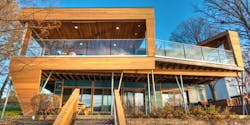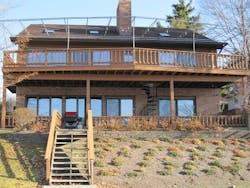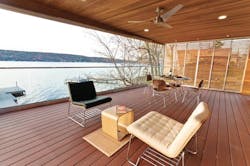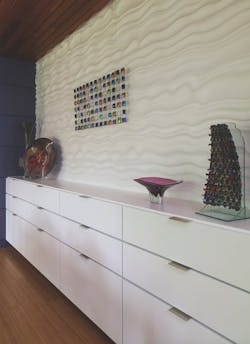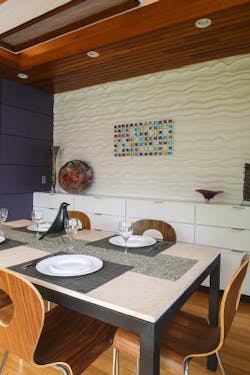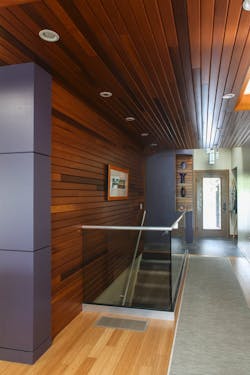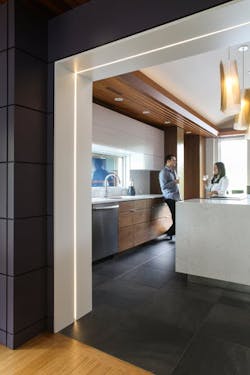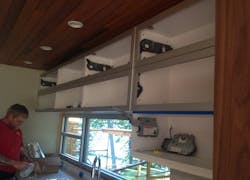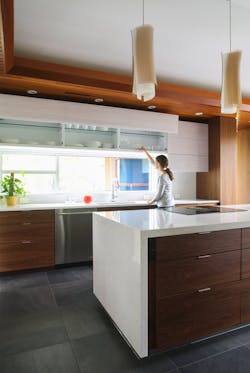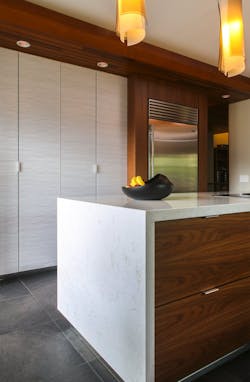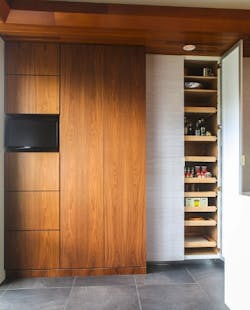You can “trust but verify,” or you can jump in and just trust. The remodel of this lakeside house, designed and executed by Bright Ideas by Martinec, is the product of the purest trust.
Trust between client and remodeler is key in all Martinec jobs, project manager Alex Martinec says, and most of the company’s work is repeat or referral for this very reason. But what made the process of remodeling this lake house remarkable was the client’s complete trust in the remodeler.
Martinec describes the homeowners as “ideal clients” who gave him a basic idea of what they wanted—and then went on vacation for almost the entire duration of the project. The remodeler took those initial ideas and ran with them, developing the design and details with just a couple of review meetings with the client before construction began.
The work on the home occurred in two distinct phases that were conceived of and executed independently, the first in 2010 (duration: four months) and the second in 2012 (duration: 12 months).
It wasn’t the first time that Built by Martinec had worked with the homeowners. Alex Martinec had already proved himself on a couple of earlier, smaller projects. But Phase 1 of the project was the first large project of his career. “It was also the first project that was most in line with my core beliefs on design,” he says.
Project Snapshot
Company: Bright Ideas by Martinec, Big Flats, N.Y.
Owner: George Martinec
Designers: Alex Martinec; assistant kitchen designer: Julie Barnard Monagan
Location: Keuka Lake, Hammondsport, N.Y.
Project Cost: Phase 1, $75,000; Phase 2, $500,000
Improvements in Stages
Phase 1 focused on the rear (lake side) of the house, enlarging and improving the exterior deck and access from the house to the water, as well as providing better exterior sun protection.
The original scope of Phase 2 was to remodel the kitchen, add an office space, and update the front of the home, but once Martinec began designing, he says the scope grew to include the dining room and entryway because the spaces in the new design were more open and better connected.
The fact that each phase was conceived separately, rather than being a continuation of a single project, plus the length of time that elapsed between phases, presented the challenge of maintaining a cohesive vision and ensuring design continuity. But Martinec’s knowledge of the site and house gained from the first phase prepared him well for fully realizing the ideas that shaped the design in Phase 2.
The key themes that drove the second phase include indoor/outdoor connection, the nature of water, spatial compression and release, and using a set palette of materials in different ways.
Drawn to Water
The site, with its water views and unique natural setting, informed the core of the design. The water also played a pivotal role and, Martinec adds, “had the most focus in the design, specifically the movement of the water and its clarity.”
But strengthening the connection between house and liquid landscape took focused effort. While working on the project, Martinec learned that the home’s previous owners, who had had the house built for them, used to live in New England and loved their home there so much that they built an exact copy on the lakeside site. “It was a house built and designed for an average residential area,” Martinec says. “And because the new lot was too narrow, they had to turn the house to make it fit. In doing so, the siting of the home largely ignored the great views and the location’s natural beauty.”
To remedy this lack of site-specific orientation, Martinec set about creating visual connection to the water and manipulating the flow of interior spaces so that occupants are drawn from the home’s entryway through the living spaces and kitchen to the lake beyond. The design intention for the deck (opposite page) was to create a multifunctional space and to continue the interior living space to the outside. It’s a journey that reveals the landscape.
On the exterior, from the driveway to the water, Martinec also consciously manipulated the journey so that your path wraps down around the house revealing the lake as you descend (just as it’s revealed as you move into and through the house). He says he’d read in an architectural design book about how a full 90-degree turn causes a psychological shift, and he purposely employed that in the design.
Finding the Wright Way
Toward the completion of Phase 1, several people told Martinec that the design looked like something Frank Lloyd Wright would design. “This is when I decided to do more serious research on Wright,” he says. “I was very inspired, the more I found out. ... Wright believed that if your efforts were successful, you couldn’t imagine that building anywhere than right where it is. It’s part of its environment.” Martinec feels that what is important in his own work—integrating spaces into a unified whole, the choice and use of materials, the relationship of interior spaces to the landscape, and manipulation of volumes of space as you move through a building—is in sync with Wright’s design approach.
Space Games
Martinec intentionally manipulated the volumes of space as you progress through the house to create a sense of compression and release. Rather than feeling like the main entry to the house, the existing entry was small, insignificant, and created a disjointed feeling as you came into the home, and there wasn’t a natural inclination of where to go. Martinec added a roof structure over the front door, making it feel deeper, and narrowed the opening. The entry was already angled—to direct people—but he accentuated this even more. There was a bulkhead that contributed to the odd sightlines of the existing entryway, but rather than leaving it as-is or removing it, he accentuated it, adding on to it so it completely covers the entry stair hall, creating that sense of compressed space.
“The [compression-release] idea suggests that if you have a low ceiling and a high ceiling, people will move through the lower section into the higher,” Martinec says. “The same concept can be applied to moving through hallways into open areas.” And that’s the point: This hall is meant to pull you toward the deck and out to the water. The horizontal orientation of the cedar on the stair wall is intended to move your eye toward the water beyond, and that cedar continues onto the soffit ceiling, creating the feeling of a tunnel that you’re naturally inclined to move through and out of toward the deck. The existing wooden stair railings and balusters were replaced with glass railings “to increase the visual space,” Martinec says, “and to simplify the hall so you focus on the cedar.”
Glass House
The homeowner has a collection of Corning glass, from nearby Corning, N.Y., but the existing home didn’t provide any opportunities for showcasing these beautiful pieces. Designing with the art in mind, Martinec set about providing places where the glass could be front and center. In addition to the dining room’s “wave wall,” the entryway’s glass shelves—glass art supported by glass—allow the artwork to “float.” Martinec notes the connection between the clarity of glass and the water theme expressed throughout the project.
That theme comes to life in several other details as well. Martinec says he used “subtle ways of pushing the water theme, as well as more overt ways,” notably, the “wave wall” panel from ModularArts; the mirrored toe-kick on the kitchen island; and the choice of material for the doors of the white kitchen cabinets above the sink and on the pantry, 3form’s Current Porcelain, which features a wavy pattern that provides a subtle design cue for water and movement.
Out on the deck, a glass railing replaces the old wooden deck railing, creating a cleaner, simpler look and allowing the structure to come forward. The glass also maximizes visual connection to and enjoyment of the lake views.
Material Manipulation
In the remodel, continuity and a cohesive aesthetic are achieved through the use of certain materials, such as Western red cedar, on both the interior and exterior. For example, the cedar—4-inch tongue and groove—is used on the interior for the soffits and ceiling transitions into the new office addition and in the entryway, and then for the fascia and soffits of the entry exterior. Western red cedar also makes its appearance in the exterior sills, the slats of the deck’s sliding screens for privacy, and as trim to cover the HardiePanel seams. This last exterior detail also creates a strong horizontal aesthetic, which, Martinec says, results in a “quieter structure” because it emphasizes the horizontal planes of the ground and water.
The 24-by-24-inch Florida tile is another material that’s used both indoors and out. Martinec says, “This is a great tile for the way I like to design. The friction coefficient is one where the tile can be used both indoors and outdoors. This tile is used in the office and kitchen … [as well as] on the walkway in front of the garage that continues to the main entryway steps and to the front door.”
Going to Great Lengths
The design of the gull-wing kitchen cabinets was a partnership between several manufacturers. The aluminum door frames are made by Element Designs, the hinges and lift mechanisms are from Blum, the door material is made by 3form (¼-inch-thick Varia Ecoresin, Artisan series, Current Porcelain), and the cabinet boxes are from National Forest Products. “The main part of the development was done with Element Designs and Blum,” Martinec says. “Both told us that this would be considered ‘experimental’ because Element designs had never made a door this long, and Blum had never lifted a door of this length.” The 9-foot-long doors are controlled by Blum’s Servo-Drive, so you can touch anywhere on the face of the doors and they lift automatically.
Martinec says that while he designed the uninterrupted runs of cabinetry to maintain visual simplicity, he was mainly concerned about ease of use. Because the house functions as a summer home, many guests are in and out throughout the season. “Either you don’t know or you’re going to forget where you put something or you’re going to go around and open every door in the kitchen,” Martinec says. “With a single door that opens multiple cabinets, the design becomes more intuitive.”
Pantry Perfection
The white pantry next to the refrigerator is made from the same 3form panel used on the cabinets above the sink. The doors are all the same size, but the cabinets are stepped in depth (3 feet, 2 feet, 1 foot) because the existing back wall of the pantry is angled. For the walnut pantry on that same wall, instead of using cabinet pulls, Martinec used Blum Tip-on touch latches that pop the doors open, allowing the natural beauty of the wood to take center stage uninterrupted. The 8-foot-tall, MDF core, walnut veneer slab doors have a machine edge with a 1/8-inch reveal that makes them appear seamless. “This is very difficult to do,” Martinec points out. Each door has six hinges to support the weight and maintain the 1/8-inch reveal. “It’s one thing to design these projects,” he points out, “but it’s another thing entirely to build them accurately.”
